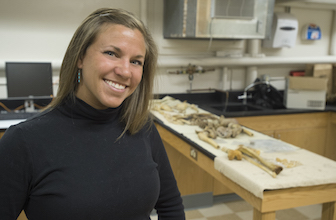Idaho State University lending forensic anthropology expertise to help solve 36-year-old cold case
March 1, 2015
Searching for a human skull from a 36-year-old cold case is an unusual and grisly endeavor for a group of 10 Idaho State University faculty, staff and students, but a valuable one.
If successful, the group can assist with the positive identification of human remains in Civil Defense caves north of Dubois near the Montana border.
 “I put the grim thoughts out of my mind,” said Kyra Stull, ISU assistant professor of anthropology and a forensic anthropologist, who is leading the team comprised of graduate students and staff from ISU’s Department of Anthropology. “If we can help identify the remains, we have the chance to solve a mystery, to help provide justice, and to possibly help a family find closure.”
“I put the grim thoughts out of my mind,” said Kyra Stull, ISU assistant professor of anthropology and a forensic anthropologist, who is leading the team comprised of graduate students and staff from ISU’s Department of Anthropology. “If we can help identify the remains, we have the chance to solve a mystery, to help provide justice, and to possibly help a family find closure.”
ISU was contacted by the Clark County Sheriff’s Office to help look into a cold case that began in 1979 when a human torso was discovered in the caves mentioned above. In 1991, the arms and legs were discovered, but the head and identity of the victim remain missing.
The case was recently reopened, and the Clark County Sheriff’s Office is looking for help from the public for any leads, and contacting ISU for professional services.
On Friday, the ISU group will travel to the caves and employ archeological techniques to try to recover the head.
“This case represents my first big forensic case since I came to ISU,” Stull said. “If it is successful, and even if it is not, it is an ideal case for us to demonstrate our capabilities and how we can assist law enforcement in a positive identification and in efficient and effective outdoor recovery of human remains.”
Depending on the conditions of the caves, the group will survey the caves using GPS, technicians from the Idaho Virtualization Laboratory will use 3D laser scanners to map the caves, and the team will possibly set up grids and complete excavations employing archeological techniques. There is a possibility the caves are partially filled with ice, which would hinder recovery efforts.
“Once we get there we will know what the possibilities are,” Stull said. “We know where the previous remains were found and there are a few suspicious areas we will go and take a look at.”
“This will be a great experience for our graduate students to get hands-on experience in the field,” Stull said. “I can teach them many things in the classroom, but being able to participate in a forensic case is a phenomenal experience for them.”
The ISU anthropology department has the skeletal remains found previously. ISU researchers have collected morphological and metric data that has allowed them to estimate a biological profile of the remains: a white male in his mid-30s to mid-40s who was 66 (5 feet, 6 inches) to 74 inches (6 feet, 2 inches) tall.
DNA samples from the remains have been sent to the National Missing and Unidentified Persons System (NamUs).
“ISU has tremendous forensic anthropology facilities and I’ve received phenomenal support from faculty members within the anthropology department, as well as in larger scale from the College of Arts and Letters and the Office of Research.” Stull said. “When I talk to my colleagues at other institutions they are impressed.”
Those research facilities include Stull’s Forensic Anthropology Laboratory in Graveley Hall, the Idaho Virtualization Laboratory in the ISU Museum of Natural History, and the Center for Archaeology, Materials, and Applied Spectroscopy (CAMAS).
If any one has information that may be pertinent to this case, they are encouraged to call the Clark County Sheriff’s Office at 208- 374-5403.
Categories:
